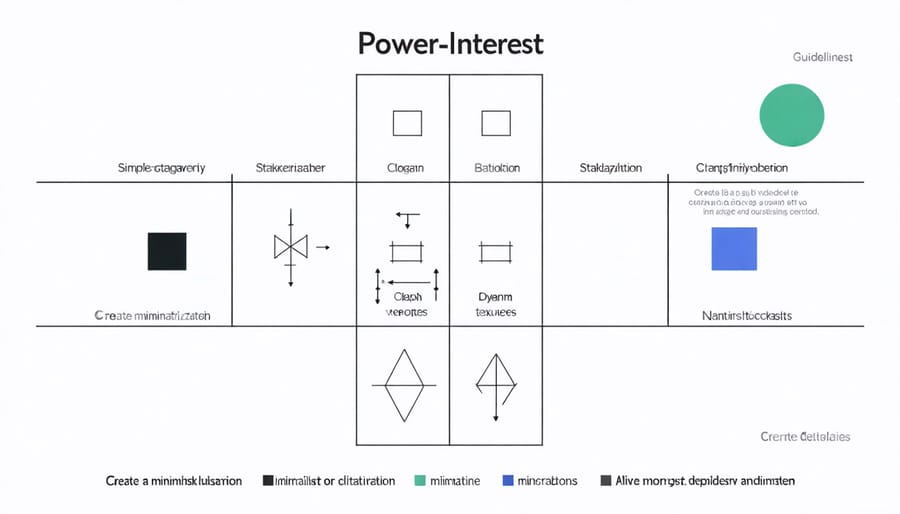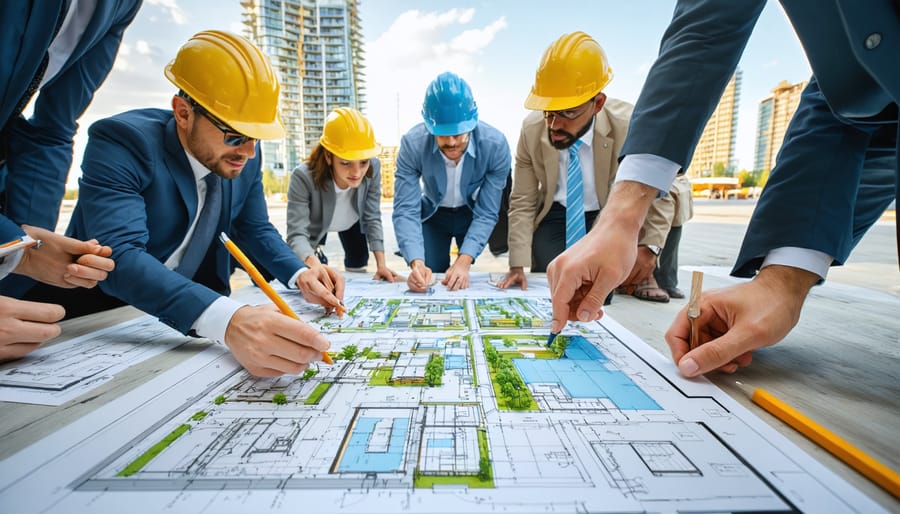In construction projects, stakeholder identification and effective stakeholder engagement directly impact project success rates by up to 85%. Key stakeholders extend far beyond the traditional triangle of owner, contractor, and architect. Primary stakeholders include project financiers, regulatory bodies, local government authorities, and end-users who directly influence project outcomes through decision-making power and financial investment. Secondary stakeholders encompass community groups, environmental organizations, and utility companies whose support proves crucial for project completion and long-term sustainability.
Understanding these stakeholder dynamics enables construction professionals to strategically allocate resources, manage risks, and navigate complex approval processes. Modern construction projects require systematic stakeholder mapping to identify influence levels, potential conflicts, and engagement priorities. This comprehensive approach to stakeholder management has become increasingly critical as projects grow in complexity and face heightened scrutiny regarding environmental impact, community benefits, and sustainable development practices.

Internal Project Stakeholders
Project Owners and Investors
Project owners and investors represent the primary financial drivers behind construction projects, wielding significant influence over project direction and decision-making processes. These stakeholders typically include private developers, institutional investors, government entities, or corporate organizations who provide the capital necessary for project execution. Their primary interests revolve around maximizing return on investment, ensuring project viability, and maintaining alignment with strategic objectives.
Effective stakeholder collaboration with owners and investors is crucial, as they often set project parameters, including budget constraints, timeline expectations, and quality standards. Their involvement extends beyond mere financial backing; they frequently participate in key decisions regarding design modifications, material selections, and project scope adjustments.
In many cases, project owners maintain long-term interests in the completed facility, whether for operational use, leasing, or future sale. This perspective influences their focus on sustainability, maintenance costs, and building lifecycle considerations. Understanding and addressing these stakeholders’ priorities is essential for project teams to deliver outcomes that satisfy both immediate construction objectives and long-term investment goals.
Construction Teams and Contractors
Construction teams and contractors form the backbone of project execution, comprising various skilled professionals who transform plans into reality. General contractors oversee the overall construction process, coordinating subcontractors and ensuring project deliverables meet specifications. These teams typically include project managers, site supervisors, skilled tradespeople, and laborers, each bringing specialized expertise to different aspects of construction.
Subcontractors play a vital role by handling specific components like electrical systems, plumbing, HVAC installation, and structural work. Their specialized knowledge and experience are crucial for maintaining quality standards and meeting technical requirements. Construction teams must also include safety officers and quality control inspectors who ensure compliance with regulations and maintain workplace safety protocols.
Equipment operators, material suppliers, and logistics coordinators work alongside construction teams to facilitate smooth project execution. Their coordination with on-site personnel is essential for maintaining workflow efficiency and preventing delays. The success of any construction project largely depends on these teams’ ability to collaborate effectively, communicate clearly, and adapt to changing site conditions while maintaining focus on project objectives and timelines.
Design and Engineering Teams
Design and engineering teams form the technical backbone of construction projects, bringing expertise that transforms concepts into buildable realities. Architects lead the creative vision, developing designs that balance aesthetics, functionality, and regulatory compliance while coordinating with various engineering disciplines.
Structural engineers ensure the building’s integrity through detailed calculations and specifications, while mechanical, electrical, and plumbing (MEP) engineers design critical building systems. Civil engineers handle site development, grading, and infrastructure connections, working closely with geotechnical specialists who assess soil conditions and foundation requirements.
Technical consultants provide specialized knowledge in areas such as acoustics, lighting, sustainability, and building envelope systems. These experts collaborate throughout the project lifecycle, from initial concept development through construction documentation and administration.
The success of modern construction projects increasingly depends on BIM (Building Information Modeling) specialists and sustainability consultants who ensure projects meet environmental standards and certification requirements. These team members must maintain constant communication with other stakeholders to resolve technical challenges and implement design modifications efficiently while maintaining project objectives and quality standards.
External Project Stakeholders
Regulatory Bodies and Local Authorities
Regulatory bodies and local authorities play a pivotal role in construction projects, serving as gatekeepers for compliance and safety standards. These stakeholders include building departments, planning commissions, environmental protection agencies, and occupational safety organizations.
At the municipal level, planning departments review and approve construction permits, ensuring projects align with local zoning laws and building codes. They conduct regular inspections throughout the construction process and have the authority to halt work if violations are found.
State and federal agencies, such as the Environmental Protection Agency (EPA) and Occupational Safety and Health Administration (OSHA), oversee broader compliance requirements. These bodies enforce regulations regarding environmental impact, worker safety, and construction standards.
Other key regulatory stakeholders include fire marshals, who review fire safety systems and emergency access plans, and conservation commissions that protect wetlands and natural resources. Historical preservation boards may also be involved in projects affecting designated historic districts or landmarks.
Successful project delivery requires early engagement with these authorities and maintaining open communication channels throughout the construction lifecycle. Understanding their requirements and incorporating them into project planning helps prevent delays and costly modifications.

Community and Environmental Groups
Community and environmental groups play a crucial role in construction projects, often representing broader public interests and environmental concerns. Local residents directly affected by construction activities serve as important stakeholders, particularly regarding issues like noise pollution, dust control, and traffic disruption. Their support or opposition can significantly impact project timelines and outcomes.
Environmental organizations, both local and national, monitor construction projects for compliance with environmental regulations and sustainable practices. These groups often possess specialized knowledge about local ecosystems and can provide valuable insights into environmental impact mitigation strategies. Their involvement early in the project planning phase can help prevent costly delays and ensure environmental compliance.
Public interest groups, including neighborhood associations and civic organizations, represent collective community interests. These stakeholders often focus on how construction projects affect local infrastructure, property values, and quality of life. Their concerns typically extend beyond the construction phase to long-term community impacts. Successful project managers actively engage with these groups through regular communication channels, public meetings, and transparent reporting mechanisms to build trust and maintain positive community relations.
Supply Chain Partners
Supply chain partners form a critical foundation in construction project success, encompassing material suppliers, equipment providers, and logistics partners who ensure seamless resource delivery and operational efficiency. These stakeholders directly impact project timelines, costs, and quality outcomes through their reliability and performance.
Material suppliers provide essential construction materials, from structural components to finishing materials, while maintaining quality standards and meeting delivery schedules. Equipment providers ensure access to necessary machinery and tools, often offering maintenance services and technical support crucial for project execution. Logistics partners coordinate transportation, warehousing, and inventory management, ensuring materials reach sites when needed.
The increasing focus on supply chain sustainability has made these partnerships even more strategic, requiring careful selection and management of partners who align with environmental and social responsibility goals. Successful projects often depend on establishing long-term relationships with reliable supply chain partners who understand project requirements, maintain consistent quality, and can adapt to changing project needs while managing risks effectively.
Stakeholder Impact Assessment
Power and Interest Matrix
The Power and Interest Matrix is a strategic tool essential for analyzing stakeholder relationships in construction projects. This matrix plots stakeholders on a two-dimensional grid based on their power (ability to influence the project) and interest (level of engagement or concern in the project outcomes).
The matrix divides stakeholders into four key quadrants. High power/high interest stakeholders, typically including project owners, major investors, and regulatory authorities, require the most active management and regular engagement. These stakeholders need comprehensive communication strategies and direct involvement in key decisions.
High power/low interest stakeholders, such as local government bodies or senior executives, should be kept satisfied but not overwhelmed with information. Regular status updates and focused communications maintain their support while respecting their time constraints.
Low power/high interest groups, often including end users, local communities, or subcontractors, need consistent information flow and engagement. While they may not directly influence major decisions, their support is crucial for project success.
Low power/low interest stakeholders require minimal but adequate monitoring. This might include peripheral suppliers or distant stakeholders who need only basic project updates.
Construction professionals should regularly reassess stakeholder positions within the matrix, as their power and interest levels may shift throughout the project lifecycle. This dynamic approach ensures appropriate resource allocation and communication strategies remain effective, ultimately contributing to successful project delivery.

Risk and Communication Planning
Effective risk and communication planning with stakeholders requires a systematic approach that balances proactive engagement with strategic risk mitigation. Begin by developing a comprehensive stakeholder communication matrix that outlines preferred communication methods, frequency of updates, and key contact persons for each stakeholder group.
Regular status meetings and progress reports should be tailored to different stakeholder interests. For example, investors may require detailed financial updates, while local communities might need information about construction impacts and timeline changes. Implement a clear escalation protocol for addressing stakeholder concerns and establish feedback channels to maintain open dialogue throughout the project lifecycle.
Risk mitigation strategies should include early identification of potential conflicts between stakeholder interests. Create contingency plans for common scenarios such as schedule delays, budget overruns, or regulatory changes. Document all stakeholder interactions and agreements to maintain accountability and prevent misunderstandings.
Consider using digital collaboration platforms to streamline communication and maintain transparent documentation. Regular stakeholder satisfaction surveys can help identify emerging issues before they become significant problems. For high-impact stakeholders, assign dedicated relationship managers to ensure consistent engagement and rapid response to concerns.
Maintain a risk register that specifically addresses stakeholder-related risks, including their likelihood, potential impact, and mitigation measures. Update this register regularly based on project progress and changing stakeholder dynamics.
Best Practices for Stakeholder Management
Implementing effective stakeholder management strategies requires a systematic approach focused on clear communication, consistent engagement, and proactive relationship building. Start by developing a comprehensive stakeholder register that documents each stakeholder’s influence, interests, and preferred communication methods.
Regular stakeholder meetings should be scheduled at predetermined intervals, with frequency adjusted based on project phases and stakeholder significance. These meetings should follow a structured agenda while allowing sufficient time for open dialogue and feedback collection. Document all discussions and decisions for future reference and accountability.
Establish clear communication protocols, including reporting structures, escalation procedures, and response timeframes. Utilize digital collaboration tools and project management software to maintain transparent information flow and ensure all stakeholders have access to relevant project updates and documentation.
Risk management should be integrated into your stakeholder engagement process. Regularly assess stakeholder satisfaction and address concerns before they escalate into larger issues. Maintain a risk register specifically for stakeholder-related challenges and develop mitigation strategies for potential conflicts.
Create value-aligned partnerships by understanding each stakeholder’s objectives and finding ways to align them with project goals. This might involve adjusting project delivery methods, incorporating sustainable practices, or modifying communication approaches to better suit stakeholder preferences.
Monitor and measure stakeholder engagement effectiveness through key performance indicators (KPIs) such as response times, meeting attendance, feedback implementation rates, and conflict resolution success. Use this data to continuously refine your engagement approach and improve stakeholder relationships throughout the project lifecycle.
Remember to maintain professional boundaries while fostering positive relationships, ensuring all interactions remain focused on project objectives and mutual success. Regular review and adjustment of your stakeholder management approach will help maintain effective collaboration throughout the project duration.
Effective stakeholder management stands as a cornerstone of successful construction project delivery. As we’ve explored throughout this article, understanding and engaging with key stakeholders requires a systematic, proactive approach that begins at project inception and continues through completion.
The complex web of relationships between owners, contractors, architects, regulatory bodies, community members, and other stakeholders demands careful orchestration. Success hinges on recognizing that each stakeholder group brings unique perspectives, requirements, and potential contributions to the project. By identifying these stakeholders early, assessing their influence and interests, and developing targeted engagement strategies, project teams can build strong foundations for collaborative success.
Remember that stakeholder management is not a one-time exercise but an ongoing process that requires regular review and adjustment. Maintaining open communication channels, documenting stakeholder interactions, and addressing concerns promptly helps prevent conflicts and ensures project objectives remain aligned with stakeholder expectations.
The investment in robust stakeholder management practices yields significant returns through reduced risks, smoother project execution, and enhanced reputation in the industry. As construction projects grow increasingly complex and interconnected, the ability to effectively manage stakeholder relationships will continue to be a critical differentiator for successful project delivery.
Moving forward, construction professionals must embrace stakeholder management as a core competency, integrating it into their project management frameworks and organizational culture. This proactive approach will help ensure project success and foster long-term relationships that benefit future endeavors.

